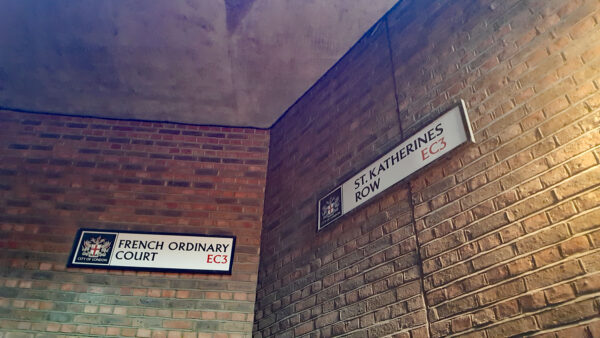An exceptionally atmospheric alley that burrows its way through history and deep under modern London.
French Ordinary Court is a curious, and fairly modern name for a route that has existed since at least Tudor times when much of this part of London was still gardens.
Opposite the modern entrance to the alley was the main gate entrance to the monastery of the Crutched Friars, so the path as it was would have enabled visitors to go to the monastery from the main Fenchurch Street to the north.
The path passed into the parish of St Katherine Coleman halfway along, and that is to prove significant to this day, as French Ordinary Court turns into St Katherine’s Row at the old boundary between the two parishes.
By the time of John Rocque’s Map of London in 1746 the area was fully built up, and the passage had gained its name of French Ordinary Court
The name comes from food — specifically venues where all the meals cost the same price. Samuel Johnson defines an ordinary in his dictionary as “a place of eating, established at a certain price”.
‘Ordinaries’ were fairly common in the City of London during the 17th and 18th centuries, as quoted in Journey throughout England of 1714, ‘not so common here as abroad, yet the French have set up two or three good ones for the convenience of foreigners, where one is tolerably well served.’
The French bit comes from the arrival of the French Huguenots who opened a number of Ordinaries in this part of London to cater to their fellow immigrants. A French style Ordinary stood on the site of the court.
The court was also somewhat larger than it is today, and open to the skies.
Its current subterranean appearance is thanks to the arrival of the railways — and Fenchurch Street station to be specific, for the alley now runs under the station, through some of the arches.
It is that which gives this alley such a delightful charm.
Starting with a fairly ordinary looking Georgian brick archway under the former home of the French Ambassador, it leads to a hidden car park underneath the railway.
But further up in a tall narrow archway, and through here, twisting around corners is the remnants of that original Tudor path, now bricked up and dark, and utterly wonderful to discover.
At the very end, at the junction of those lost parishes, the alley transforms into another alley, but that’s also for another day.










